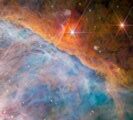June 26 () –
An international team of scientists has used data collected by the James Webb Space Telescope NASA/ESA/CSA to detect for the first time a carbon molecule known as a methylene cation (CH3+), located in the planet-forming disk (protoplanetary) that surrounds a young star, according to a study carried out by a team with Spanish participation.
The methylene cation is considered “especially important” as it has the property of reacting with a wide range of molecules and thus initiate the growth of other more complex ones and this is the first time that it has been detected since its “vital role” in interstellar carbon chemistry was theorized in the 1970s.
Specifically, it has been located in the planetary disk d203-506, located about 1,350 light years away, in the Orion nebula. It is a small red dwarf star, with a mass of only one tenth of that of the Sun, which is bombarded by strong ultraviolet radiation, as detailed in a statement on Webb’s website.
In this sense, it has been emphasized that most protoplanetary disks that form planets go through a period of intense ultraviolet radiationas would have happened in the protoplanetary disk that gave rise to the Solar System, which was also subjected to a large amount of ultraviolet radiation emitted by a companion star of the Sun that died long ago.
Thus, the study predicts that the presence of CH3+ is related to ultraviolet radiation, which provides the necessary energy source for CH3+ to form. The period of ultraviolet radiation experienced by certain disks seems to have a profound impact on their chemistry since, for example, Webb’s observations of protoplanetary disks that are not subjected to intense ultraviolet radiation from a nearby source show a great abundance of water, in contrast to d203-506, where the team could not detect water at all.
The main author, Olivier Berne, from the University of Toulouse (France), has explained in this regard that “this clearly demonstrates that ultraviolet radiation can completely change the chemistry of a protoplanetary disk.” “In fact, it could play a critical role in the early chemical stages of the origins of life by helping to produce CH3+, something that may have been previously underestimated.“, he has sentenced.
For her part, the spectroscopist and member of the study’s scientific team, Marie-Aline Martin, from the University of Paris-Saclay (France), has highlighted that “this detection of CH3+ not only validates the incredible sensitivity of James Webb, but also also confirms the postulated central importance of CH3+ in interstellar chemistry.”
“Our discovery was only possible because astronomers, modellers, and laboratory spectroscopists joined forces to understand the unique features observed by James Webb.“, has added about the study, in which researchers from the Institute of Fundamental Physics and the National Astronomical Observatory have participated.












